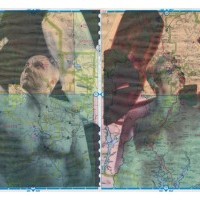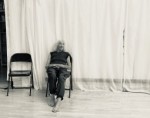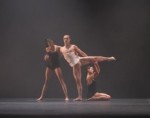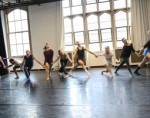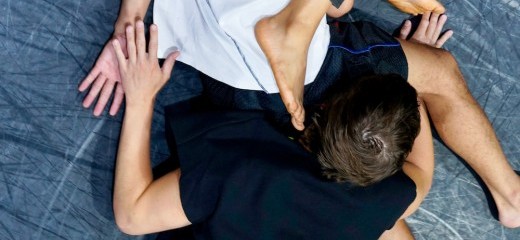
Choreography at the End
by Brendan McCall
According to artist and educator Miguel Gutierrez, Super Nothing is a blueprint for survival.
When he began creating this latest work through a residency at the Maggie Allesee National Center for Choreography, he wanted to use his art to confront the near-constant feeling of grief coursing through the veins of him and everyone he knew. As he completed the piece over a two-year process through the 2023-24 Randjelovic/Stryker Resident Commissioned Artist award, he and his collaborators found that the act of making was a vital coping mechanism. In a world of injustice, discrimination, and violence, dancing was a potent act of political defiance.
While sitting in the packed house on opening night of Super Nothing at New York Live Arts, I couldn't stop thinking about the wildfires consuming Los Angeles County. While witnessing what Gutierrez calls a “choreography at the end of the world,” his dancers performing with a fierce intensity, I was simultaneously aware that the home of Gutierrez and half of his creative team was literally ablaze. Super Nothing is a scream of raw beauty, an unapologetic display of artistic endurance that is absolutely invigorating.
The piece opens with a kind of dystopian prank. With the house lights still on and all of us viewing the empty space waiting for the show to start, it seems we’re all listening to the familiar pre-show announcement about fire exits, turning off cell phones, and a land acknowledgment. But as the text continues, we learn that this is a recording, one whose coherency is gradually de-evolving through repetition and an unusual jumbling of words. In addition to this scramble, the tone of the original voice becomes increasingly distorted and artificial.
A short textured duet between Justin Faircloth & Wendell Grey II follows before Jay Carlon and Evelyn Lilian Sanchez Narvaez join them, the quartet remaining onstage together for nearly ninety minutes in a series of dance sequences that hardly take a break. The space frequently erupts with the performers´intricate floor patterns or the sharp lines made by their limbs, before they forge quieter moments as contrast. Recurring themes emerge during the course of Super Nothing, such as when the dancers embrace in solidarity and comfort, gripping each other's hands or lying on top of one another. The dancers also frequently twitch and tremble throughout their entire bodies, as if to show terror; in other moments they twerk their hips with either flirtation or professional detachment, their bodies hustling in a commodified form of sexuality.
The piece is beautifully lit by designer Carolina Ortiz, who chooses seemingly simple washes of light to make bold statements. The original music by composer Rosana Cabán couches the intricacies of Gutierrez’s choreography, providing space for us to absorb the details of what we see as well as be moved by what we hear. Jeremy Wood’s costumes augment each dancer’s individual personality, allowing them to move comfortably without sacrificing an iota of style.
Throughout his career, Gutierrez has cultivated a distinctive choreographic vocabulary, and this latest work encapsulates many of the ingredients that make his performances so sensual and smart. The four gifted dancers effortlessly blend multiple movement idioms over the course of this exceptional piece. There are clear references to contemporary modern dance that will be familiar to a New York art audience; but Gutierrez´s sly vocabulary also includes moves you’ve probably done on the floor of a dance club or (as well as seen writhing around a pole). The physical and temporal form of Super Nothing is intentionally littered with these and other unpretentious gestures, making the performance into both a dance as well as an interrogation. What is “correct” to do on stage? What is or is not allowed in a contemporary dance, and who gets to decide? Who “gets” to perform today, and how can we listen more to the voices of dance artists of color? Such inquiries have restlessly occupied Gutierrez for years, both in his artistic work and in his droll and informative podcast series Are You For Sale? Questions surrounding the intersection of identity, class, and art circulate throughout Super Nothing, even though none of the dancers utter a single word. Instead, through his idiosyncratic selection of physical actions, Gutierrez makes art which is queer and exciting, loud and proud.
The lights frequently remain on the audience throughout the performance, as if Gutierrez is asking us to bring ourselves and our world onto the stage with his dancers and with his art. The conclusion starts with an absolutely riveting extended solo by Carlon, then the four dancers come close to us, allowing us to see the accumulation of sweat glistening across their skin. Later, they echo this spatial design further away along the upstage wall, this time with a much simpler unison sequence whose movements feel both ritualistic and melancholic. Is their gaze an appeal? Or maybe it is a challenge from Gutierrez and his dancers: if we can dance despite all the grief, why can't you?
Super Nothing, Miguel Gutierrez, New York Live Arts, January 12-18.
Homepage Image Description: An African American man wearing a yellow shirt leans his head towards the camera, against the chest of a white man with a mustache, while at the same time being gently pulled in the other director by a third dancer with gold hair.
Article Page Image Description: A bird´s eye view of four bodies, their faces unseen but their limbs intertwined and entangled around one another.
By Brendan McCall
January 18, 2025

